
Liposuction is an increasingly popular surgical procedure, and it is one that I perform often at my clinic. It is a very effective way to streamline the body’s silhouette, remove stubborn pockets of fat in a variety of locations, and for the creation of a smoother body contour. However, there are some myths about the procedure – both what’s involved and what it can achieve – so here, I would like to outline some of the key points about liposuction (often referred to as lipo).
This is perhaps the most common misconception about liposuction. The procedure is not the best option for someone who wants to remove a lot of excess fat, but it can help deal with specific smaller areas or pockets of fat, such as on the stomach or midriff, areas of the lower body such as the thighs and buttocks, the backs of the arms, and even the chin. They are the sort of little lumps and bumps that seem to persist, despite a good healthy diet and adequate exercise.
Any and all surgeries or medical procedures carry a certain element of risk (and this should be clearly outlined to you when you meet your surgeon at the consultation stage). However, there is still a perception that liposuction is particularly risky or complicated. That is not the case anymore.
In the past, it was indeed a big procedure and there was a risk of serious blood loss, but in the 1980s a new technique called the tumescent technique was introduced. It means that large volumes of fat can be removed at a time, without the associated large blood loss, making it safer for the patient to restore or enhance their body shape and enjoy a greater level of self- confidence.

Liposuction is actually a relatively straightforward surgery to undergo, with manageable downtime and usually very good results. I find there is a high rate of patient satisfaction at my clinic, and the effects can be significant and long-lasting.
The procedure is usually done under general anaesthetic, and usually just leaves discrete scarring. It involves the use of special probes, which come in a variety of sizes. They are inserted through small incisions in the skin and the excess fat is removed through them.
While recovery can be specific to each patient, and the surgical procedures used, generally the recovery and aftercare requirements are less significant than people might imagine.
Compression garments may be required for certain areas of the body for support and to encourage proper healing, but for most people there is likely to be just a matter of dealing with mild pain or stiffness in the days following treatment – paracetamol may be the only pain medication required. Patients will have to follow aftercare instructions carefully, however. For example, they may be able to return to work after one week or less, but may have to hold off on anything other than light exercise for a little while longer.
Prior to any sort of surgery, I always encourage the patient to be as healthy as possible. When it comes to liposuction, giving up smoking (temporarily or, ideally, for good) is very important.
Smoking can hinder the recovery process and can bring added risks to surgery, so this is something I always emphasise.
Similarly, taking blood-thinning tablets such as aspirin or warfarin are not a good idea prior to liposuction, but this would always be clearly laid out at the consultation stage.
It is also worth noting that the full results of a liposuction procedure won’t be seen for a few months after the surgery and, with a healthy lifestyle, they can be long lasting.
If you are considering liposuction or any other cosmetic surgery procedure, I can advise on the best options for you. Contact us to arrange a consultation.
Find out all you need to know about cosmetic procedures and the factors you need to consider in our free guide: Considerations Before Deciding on Cosmetic Surgery and Post-Treatment Care:
Download Mr. Chan's Guide to Cosmetic Surgery Considerations

Liposuction is an increasingly popular surgical procedure, and it is one that I perform often at my clinic. It is a very effective way to streamline the body’s silhouette, remove stubborn pockets of fat in a variety of locations, and for the creation of a smoother body contour. However, there are some myths about the procedure – both what’s involved and what it can achieve – so here, I would like to outline some of the key points about liposuction (often referred to as lipo).
This is perhaps the most common misconception about liposuction. The procedure is not the best option for someone who wants to remove a lot of excess fat, but it can help deal with specific smaller areas or pockets of fat, such as on the stomach or midriff, areas of the lower body such as the thighs and buttocks, the backs of the arms, and even the chin. They are the sort of little lumps and bumps that seem to persist, despite a good healthy diet and adequate exercise.
Any and all surgeries or medical procedures carry a certain element of risk (and this should be clearly outlined to you when you meet your surgeon at the consultation stage). However, there is still a perception that liposuction is particularly risky or complicated. That is not the case anymore.
In the past, it was indeed a big procedure and there was a risk of serious blood loss, but in the 1980s a new technique called the tumescent technique was introduced. It means that large volumes of fat can be removed at a time, without the associated large blood loss, making it safer for the patient to restore or enhance their body shape and enjoy a greater level of self- confidence.

Liposuction is actually a relatively straightforward surgery to undergo, with manageable downtime and usually very good results. I find there is a high rate of patient satisfaction at my clinic, and the effects can be significant and long-lasting.
The procedure is usually done under general anaesthetic, and usually just leaves discrete scarring. It involves the use of special probes, which come in a variety of sizes. They are inserted through small incisions in the skin and the excess fat is removed through them.
While recovery can be specific to each patient, and the surgical procedures used, generally the recovery and aftercare requirements are less significant than people might imagine.
Compression garments may be required for certain areas of the body for support and to encourage proper healing, but for most people there is likely to be just a matter of dealing with mild pain or stiffness in the days following treatment – paracetamol may be the only pain medication required. Patients will have to follow aftercare instructions carefully, however. For example, they may be able to return to work after one week or less, but may have to hold off on anything other than light exercise for a little while longer.
Prior to any sort of surgery, I always encourage the patient to be as healthy as possible. When it comes to liposuction, giving up smoking (temporarily or, ideally, for good) is very important.
Smoking can hinder the recovery process and can bring added risks to surgery, so this is something I always emphasise.
Similarly, taking blood-thinning tablets such as aspirin or warfarin are not a good idea prior to liposuction, but this would always be clearly laid out at the consultation stage.
It is also worth noting that the full results of a liposuction procedure won’t be seen for a few months after the surgery and, with a healthy lifestyle, they can be long lasting.
If you are considering liposuction or any other cosmetic surgery procedure, I can advise on the best options for you. Contact us to arrange a consultation.
Find out all you need to know about cosmetic procedures and the factors you need to consider in our free guide: Considerations Before Deciding on Cosmetic Surgery and Post-Treatment Care:
Download Mr. Chan's Guide to Cosmetic Surgery Considerations